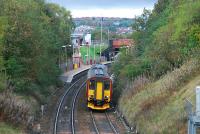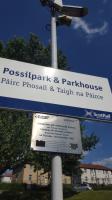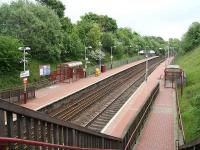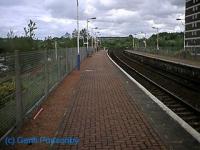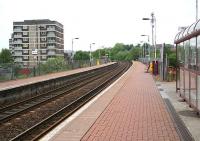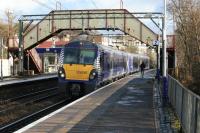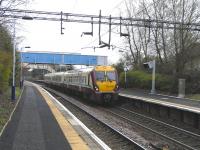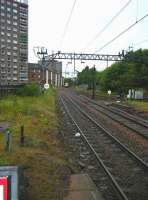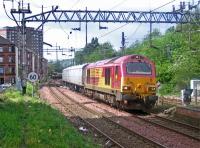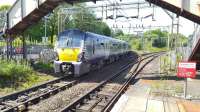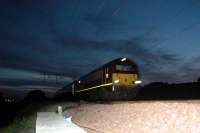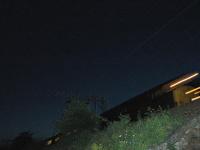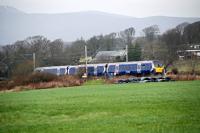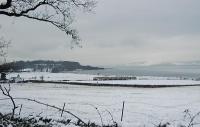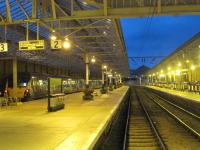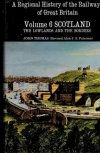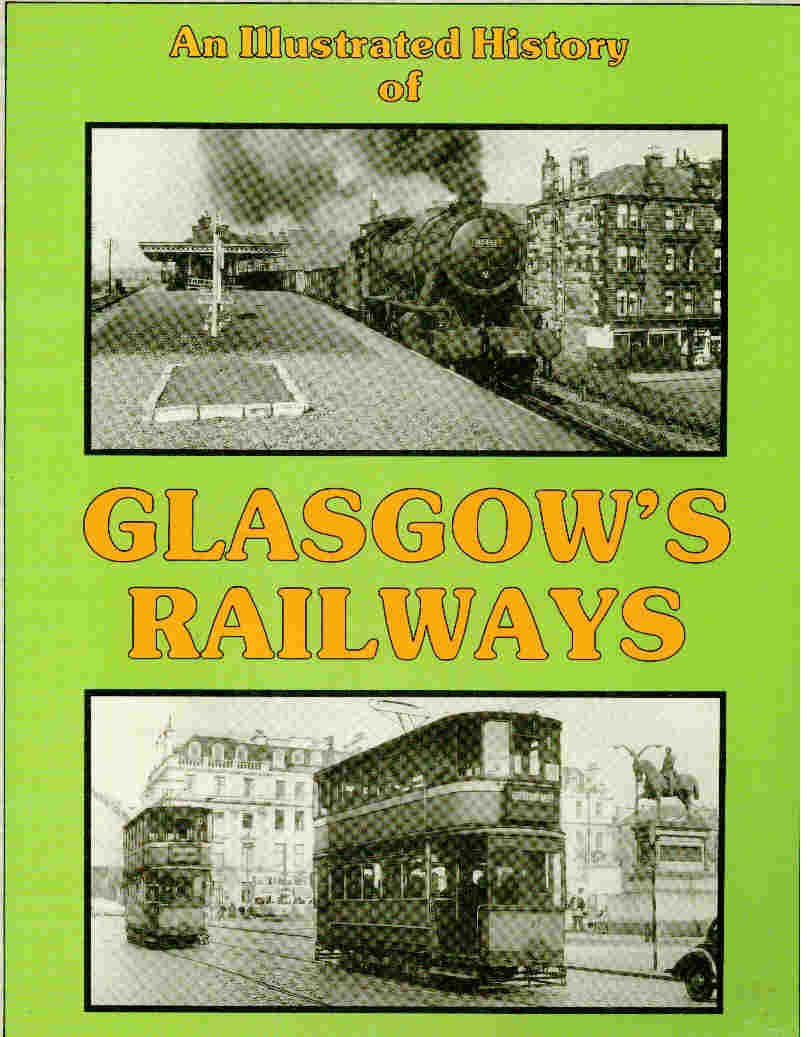Glasgow, Dumbarton and Helensburgh Railway
Introduction
This railway runs between Helensburgh and Cowlairs, Glasgow. The section of line between Dumbarton (Dalreoch Junction) and Bowling was built by the Caledonian and Dumbartonshire Junction Railway who had failed to build lines to both Helensburgh and Glasgow.
The line between Glasgow Queen Street High Level and Anniesland is supported and promoted by the Glasgow North Community Rail Partnership .
Dates
Portions of line and locations
This line is divided into a number of portions.
Cowlairs to Bowling
This portion runs from Cowlairs West Junction to Bowling where and end-on junction was formed at the station.
This is a four way junction. The 1842 Edinburgh and Glasgow Railway is met by the 1855 Sighthill Branch (Edinburgh and Glasgow Railway) and the 1858 Glasgow, Dumbarton and Helensburgh Railway. The City of Glasgow Union Railway's north end reached here in 1875. In addition the Cowlairs Works was to the south, on the west side.
...
See also
Edinburgh and Glasgow Railway
City of Glasgow Union Railway
Sighthill Branch (Edinburgh and Glasgow Railway)
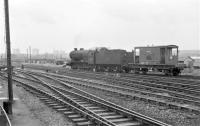
Robin McGregor 21/08/1965
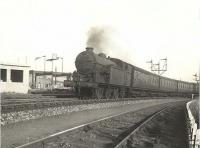
G H Robin collection by courtesy of the Mitchell Library, Glasgow 06/09/1955
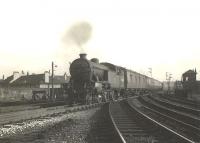
G H Robin collection by courtesy of the Mitchell Library, Glasgow 06/09/1955
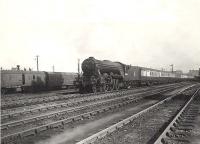
G H Robin collection by courtesy of the Mitchell Library, Glasgow 26/06/1956
This junction is at the western point of a triangular junction. It opened in 1876 when a chord from Cowlairs East Junction opened. The chord is presently single but was double. It links the Glasgow, Dumbarton and Helensburgh Railway to the Edinburgh and Glasgow Railway and is effectively a Glasgow bypass.
...
See also
Cowlairs North Junction to Cowlairs East Junction (North British Railway)
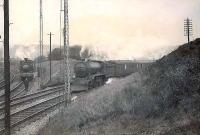
G H Robin collection by courtesy of the Mitchell Library, Glasgow 09/04/1949
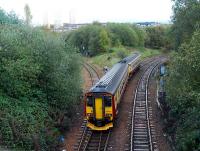
Ewan Crawford 28/10/2006
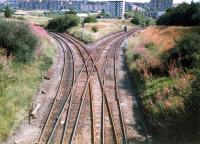
Ewan Crawford //1987
This is a minimal modern two platform station just west of Cowlairs North Junction.
...
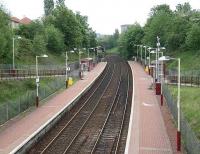
John Furnevel 04/04/2007

David Panton 08/08/2009
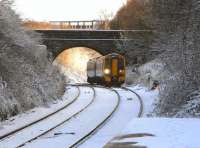
David Panton 27/11/2010
This was a double track junction between the Glasgow, Dumbarton and Helensburgh Railway (1858) and the Ruchill Goods Branch (North British Railway) (1879).
...
See also
Ruchill Goods Branch (North British Railway)
This is a two platform station on the east side of Balmore Road, the A879. Facilities are fairly minimal consisting of shelters on the platforms.
...
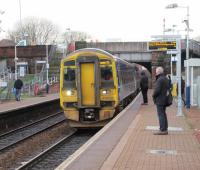
David Panton 11/12/2019
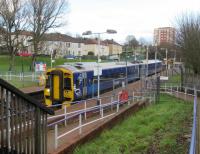
David Panton 11/12/2019
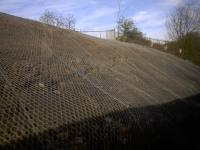
Colin McDonald 12/04/2017
This station was west of Balmore Road. Nothing remains to be seen of it today. It was a basic station with platforms and shelter. After the Great War it was an unadvertised station.
...
The double track line passes under the Forth and Clyde Canal via a pair of parallel single track tunnels. The original course of the canal was to the immediate south east, with the tunnel and deviation of the canal being built, and the canal diverted to accommodate the Glasgow, Dumbarton and Helensburgh Railway.
...
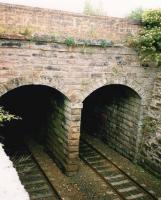
James C Wilson Collection //1995
This was a two platform station to the west of West Possil Loch and the Lochburn Iron Works. The main station building was on the eastbound (Glasgow) platform. When built it was in an area, largely of farmed countryside, north of Glasgow. To the south east the line passed under the Forth and Clyde Canal.
...
This is a minimal modern two platform station located in a deep cutting east of the Lochburn Road road bridge over the line. It opened with the re-opening of the Maryhill line to local passenger trains in 1993. Prior to that the line was only served by non stop West Highland Line trains.
...
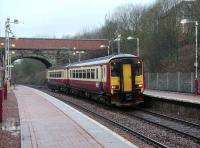
David Panton 08/03/2008
This is a two platform station. The station serves the Summerston area. This development is a little south of Summerston Farm, which was served by Summerston [1st] station.
...
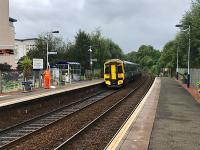
Colin McDonald 29/08/2017
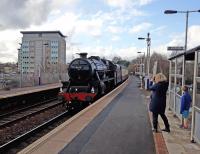
Rod Crawford 17/02/2019
The Kelvin Valley Railway (1879) met the existing Glasgow, Dumbarton and Helensburgh Railway (1858) at a junction which allowed eastbound trains to take the branch from the main line. The junction was also known as Kelvin Valley Junction.
...
See also
Kelvin Valley Railway
This goods yard was to the east of Maryhill station, on the south side of line. It was served from a goods loop, a pair of looped lines west to the west on south side of main line. The goods yard sidings were approached from east.
...
This is a two platform station in the north of Maryhill. The current station is a reopening of 1993 on the site of the earlier station. Maryhill Park Junction opened to the west in 2005 along with a single track line to a bay platform at Anniesland.
...
See also
Stobcross Railway

David Panton 21/07/2018
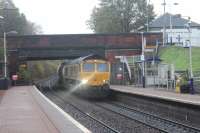
...
Alastair McLellan 31/10/2017

...
Alastair McLellan 30/10/2017
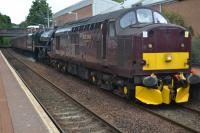
Iain Teaz 13/07/2020
The site of this paper mill is now and area of grass parkland, within Dawsholm Park, on the west bank of the River Kelvin, just south of the old Dawsholm Bridge. The mill was opened by William McArthur. It consisted of two ranges of buildings parallel to the river. A mill lade ran between the buildings and there were three small reservoirs to the west.
...
This junction was immediately west of Maryhill Park station and east of the Maryhill Viaduct [GDH]. It was formed with the opening of the Stobcross Railway in 1874, a branch from the 1858 Glasgow, Dumbarton and Helensburgh Railway serving the west of Glasgow, Partick and the Queens Dock.
...
See also
Stobcross Railway
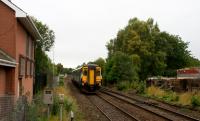
Colin McDonald 23/09/2015
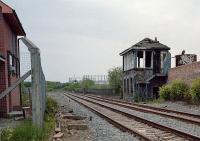
Ewan Crawford 29/05/1987
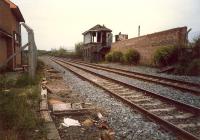
Ewan Crawford //1987
This is a double track seven arch viaduct over the River Kelvin built for the Glasgow, Dumbarton and Helensburgh Railway. During construction, in 1857, five arches collapsed (the viaduct may have originally had nine arches). Alternative names are the Dawsholm Viaduct (which can be confused with the Dawsholm Viaduct a Dawsholm) and Kelvin Viaduct (could be confused with the [[Kelvin ...
More details
Ewan Crawford 03/10/2004
This is a single lead junction, opened in 2005, west of Maryhill station located about mid way over the Maryhill Viaduct [GDH], with the single line to Anniesland crossing over to the parallel Maryhill Viaduct [SR] at the west end of the viaducts.
...
See also
Maryhill Park Junction [2nd] (Network Rail)
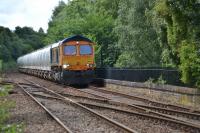
...
Iain Teaz 13/07/2020
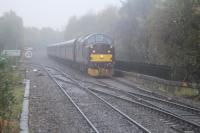
...
Alastair McLellan 31/10/2017

Colin McDonald 23/09/2015
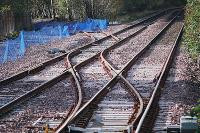
Ewan Crawford //
This signal box was west of Maryhill Central Junction. It was located at the west end of a set of looped sidings on the south side of the Glasgow, Dumbarton and Helensburgh Railway, the east end of these loops being at Maryhill Central Junction (that junction was renamed from Maryhill West Junction on the opening of the west box and sidings).
...
This is a single lead junction where the double track line between Westerton station and Anniesland is met by a single track from Cowlairs West Junction, this doubling shortly after the junction going east. (The junction has been converted into a single lead junction.) It is located just north of the Forth and Clyde Canal.
...
See also
Glasgow City and District Railway
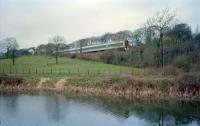
Ewan Crawford //1994

Rod Crawford 12/04/2020
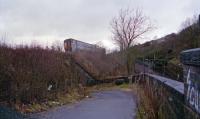
Ewan Crawford //1994
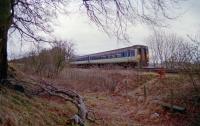
Ewan Crawford //1994
This is a two platform station, the junction between the Helensburgh line and the Milngavie line is immediately to the west.
...

John McIntyre 07/09/2019

Robin McGregor //

John McIntyre 07/09/2019
This junction is immediately west of Westerton station. Here trains leaving Glasgow divide between the line west and the Milngavie branch.
...
See also
Glasgow and Milngavie Junction Railway
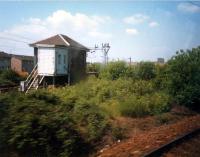
Ewan Crawford //1987

...
David Prescott 13/06/2018
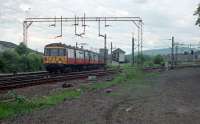
Ewan Crawford 06/06/1989

Ewan Crawford //
This was a Merry and Cunningham ironstone and coal colliery. It closed around 1879. Drumchapel Row was just to the north.
...
This is a two platform station close to Old Drumchapel with Drumchapel to the north. The main station building is on the eastbound platform.
...

David Panton 13/01/2018

John McIntyre 07/09/2019
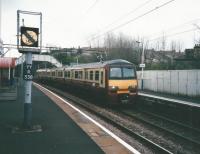
David Panton 02/04/1998

David Panton 01/12/2018
This is a minimal two platform station.
...
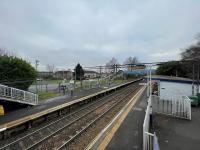
Network Rail //2021
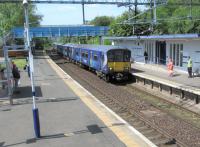
David Panton 19/05/2018
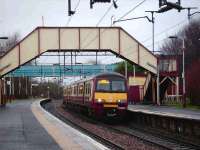
David Panton 23/02/2008
East of Singer station the Singer Deviation (North British Railway) left the former Glasgow, Dumbarton and Helensburgh Railway. This signal box controlled the point of deviation between the original and deviation lines. The original line layout was altered at the junction to provide carriage sidings. Kilbowie [1st] station was closed and became goods sidings alongside the [[Singer ...
More detailsSee also
Singer Deviation (North British Railway)
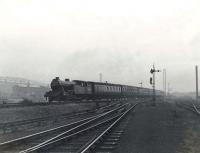
G H Robin collection by courtesy of the Mitchell Library, Glasgow 12/04/1958
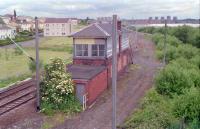
Ewan Crawford //1989
This was a huge sewing machine factory which was noted for its tall clock tower, 200 feet high, the second highest in the world. It was opened at Kilbowie in 1883/4 for a company based in the United States, the Singer Sewing Machine Company, replacing a smaller factory (of 1867) in Bridgeton, Singer Works [Bridgeton]. When opened the new factory was on a greenfield site with a low local ...
More detailsThis was a two platform station opened in 1879 on a line opened in 1856. It was built just as the area became industrial, particularly just in advance of the opening of the Singer Works in 1884. It was located on the east side of Kilbowie Road, south of today's Singer station (on the west side of the road) which replaced it. The station had its main building on the northern platform. There ...
More detailsThis siding, east of Dalmuir [1st], was owned by W. V. V. Lidgerwood, Speedwell Iron Works. The siding made a trailing connection to the westbound line just east of the station.
...
The works of Somervail & Co, builders of steel and iron bridges, roofs and general structural works was established by Peter Alexander Somervail in 1887. Products of this company (chiefly girder bridges although lattice footbridges and roofs were also manufactured) can be found all over the railway network in Scotland.
...
This was a two platform station. In 1897 it was replaced by Dalmuir on the west side of Duntocher Road when the Glasgow, Yoker and Clydebank Railway was extended by the North British Railway from Clydebank Junction west to Dalmuir Park Junction.
...
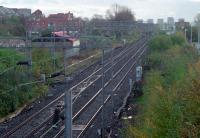
Ewan Crawford //1989
This is a five platform station. There are two platforms on the Singer route and to the north two platforms on the Clydebank route and a bay to the north of those, served from the Clydebank direction.
...
See also
Clydebank to Dalmuir (North British Railway)
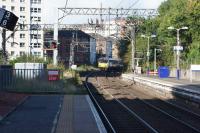
John McIntyre 08/10/2015

John McIntyre 08/09/2019
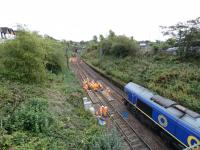
Network Rail /09/2023
This became a junction in 1897 when the former Glasgow, Yoker and Clydebank Railway was extended west from Clydebank Junction west to Dalmuir.
...
See also
Clydebank to Dalmuir (North British Railway)
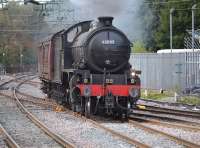
Bill Roberton 20/10/2017
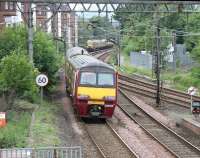
John Furnevel 27/07/2005
This is a two platform station. An original single storey station building remains on the westbound platform (another example survives at Cardross). The building is extended at the east end. The station is to the north of, and above, the village.
...
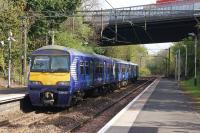
John McIntyre 27/04/2017
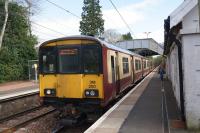
John McIntyre 27/04/2017
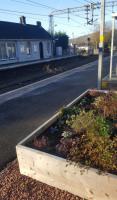
John Yellowlees 08/01/2019
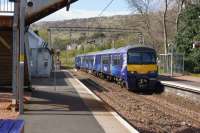
John McIntyre 27/04/2017
These sidings were on the south side of the line east of Bowling station. They served both Bowling Harbour (north east corner) and Bowling Basin, the west end of the Forth and Clyde Canal.
...
See also
Caledonian and Dumbartonshire Junction Railway
This signal box was on the north side of the line, east of Bowling station opposite Bowling Harbour. It controlled access to the sidings on the south side of the line which ran to Bowling Canal Basin, of the Forth and Clyde Canal, just to the east and the quay and coal bunkering sidings at the east end of Bowling Harbour, served with mobile cranes.
...
See also
Caledonian and Dumbartonshire Junction Railway
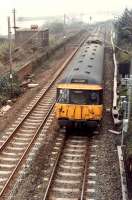
Ewan Crawford //1990
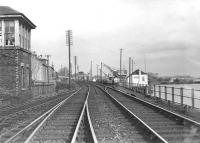
G H Robin collection by courtesy of the Mitchell Library, Glasgow 19/04/1957
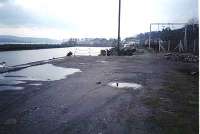
Ewan Crawford //
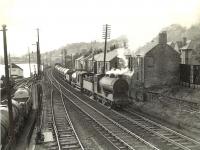
G H Robin collection by courtesy of the Mitchell Library, Glasgow 19/04/1957
This is a two platform station in the south of Bowling at at the north west end of Bowling Harbour. Today it is a minimal station with platforms, shelters, parking and a footbridge. It has a interesting history. Between 1850 and 1858 it was a terminus for trains from Balloch and Dumbarton, passengers for Glasgow having to complete their journey by water. It was initially known as ...
More detailsSee also
Caledonian and Dumbartonshire Junction Railway

...
Bill Roberton //1991
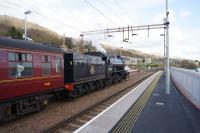
John McIntyre 27/04/2013
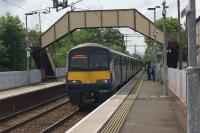
John McIntyre 02/06/2019
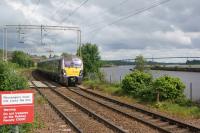
John McIntyre 02/06/2019
Dalreoch to Helensburgh
This portion runs from Dalreoch Junction to Helensburgh Central. The portion through Craigendoran is a later deviation.
This is a double track junction to the immediate west of Dalreoch station.
...
See also
Caledonian and Dumbartonshire Junction Railway
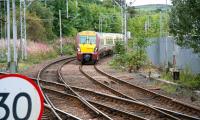
John Furnevel 09/09/2007
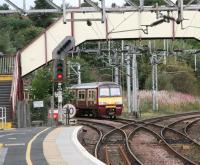
John Furnevel 09/09/2007
There are two single bore tunnels west of Dalreoch Junction and Dalreoch station on the route to Helensburgh Central and the West Highland Railway. The tunnels are 603 yds long.
...
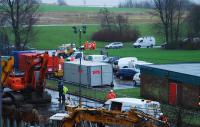
Ewan Crawford 18/01/2007
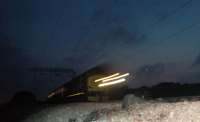
So farewell then English Electric Type 3,
Your engine sounds nice,
But wakes us from ...
Ewan Crawford 09/06/2006
After the doubling of the Helensburgh Central to Dalreoch Junction line, Dalreoch Tunnels remained a single bore single track tunnel. This signal box protected the west end of the single track tunnel until the second bore was added. It remained in use afterwards until 1926. The box was renamed Dalreoch West. ...
More details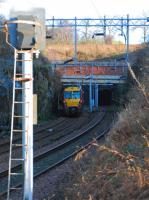
Ewan Crawford 05/01/2007
This quarry is shown on the Railway Clearing House maps 66 chains west of the Dalreoch Tunnels.
...
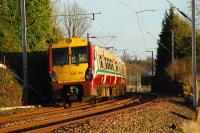
Ewan Crawford 05/01/2007
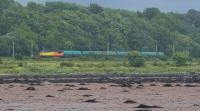
Ewan Crawford 02/07/2017
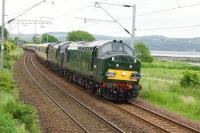
John McIntyre 12/06/2021
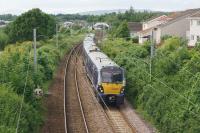
John McIntyre 16/06/2021
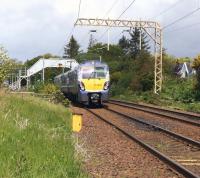
John McIntyre 31/05/2015
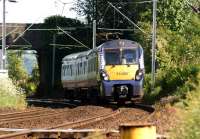
John McIntyre 31/5/2014
This is a two platform station which retains its original Glasgow, Dumbarton and Helensburgh Railway single storey station building on the eastbound platform. A similar building survives at Kilpatrick.
...
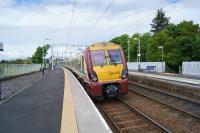
John McIntyre 03/06/2013
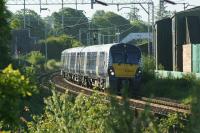
John McIntyre 28/06/2021
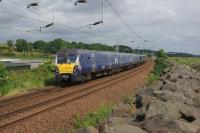
John McIntyre 16/06/2021
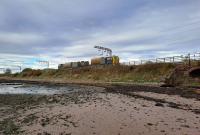
Beth Crawford 03/11/2023
This level crossing is immediately west of Cardross station. ...
More details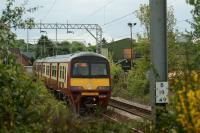
John McIntyre 29/05/2010
This level crossing is west of Cardross station and the station level crossing. It is also known as Geilston Level Crossing. To the west is Geilston Farm Level Crossing.
...

John McIntyre 02/07/2021
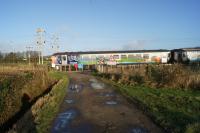
John McIntyre 04/01/2022
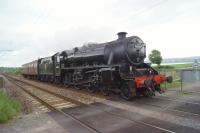
John McIntyre 12/06/2021
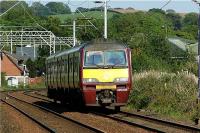
John McIntyre 30/05/2009
An occupational level crossing to the west of Cardross. ...
More details
Ewan Crawford 22/02/2016
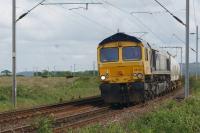
John McIntyre 01/06/2019

John McIntyre 01/06/2019
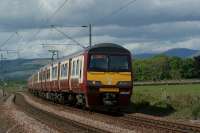
John McIntyre 28/05/2010
There was a signal box here by the level crossing, on the east side of the line south of the crossing. The box closed in 1943, replaced by Ardmore East Signal Box.
...
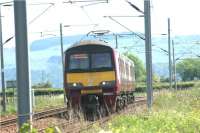
John McIntyre 01/06/2009
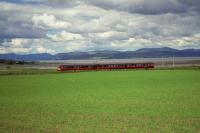
John McIntyre 04/05/1994
This wartime signal box, of 1943, was north of Ardmore Level Crossing and located on the west side of the railway. The box controlled the approach to the south end of Ardmore Yard, associated with Faslane Military Port.
...
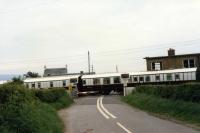
John McIntyre Collection //1985
This yard was built in the Second World War, partly for the Clyde Boom Defence and, more particularly, for the marshalling of trains heading to Faslane Military Port, and other wartime sidings such as Craigendoran West and East Yards, Spean Bridge, {{Fort Augustus]], Mallaig Junction Yard, Annat Sidings or Achaleven Sidings. With the West Highland Railway being single ...
More details
Ewan Crawford 31/07/2005
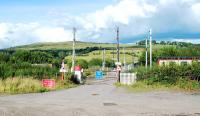
Ewan Crawford 31/07/2005
This wartime signal box of 1943 was north of Moss Road Level Crossing and located on the east side of the railway. The box controlled the approach to the north end of Ardmore Yard, associated with Faslane Military Port. The buffer stops of the eastbound yard were just to the south over Moss Road.
...
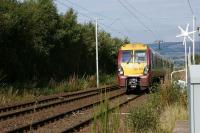
John McIntyre 23/09/2012
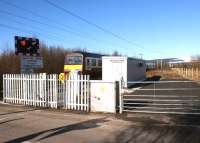
John McIntyre 01/03/2010

John McIntyre 28/05/2007
This wartime yard was opened to the east of Craigendoran Junction along with Craigendoran West Yard. Access was controlled by Craigendoran East signal box. The yard was laid out on the north east side of the line. It had two sets of sidings and a turntable, all approached from the west. The yards were used in combination with Ardmore Yard for Faslane Military Port.
...
See also
Military Port Number 1 Railway
The pier platform lines met the Helensburgh line east of Craigendoran station. This was remodelled in 1894 into a junction proper when the West Highland Railway opened. This was a double track junction, the West Highland becoming single track north of Craigendoran Upper station.
...
See also
West Highland Railway
Craigendoran Pier Deviation

John McIntyre 02/07/2021
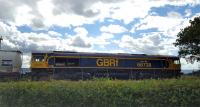
Beth Crawford 09/08/2018
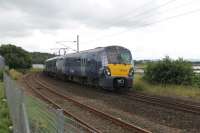
Mark Bartlett 30/07/2017
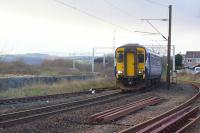
John McIntyre 27/01/2022
This wartime yard was to the north of Craigendoran Junction. It was part of the provision of marshalling yards for the Faslane Millitary Port. A series of sidings, mostly approached from the east, was laid out. Craigendoran East Yard could be reached by reversal.
...
See also
Military Port Number 1 Railway
This gas works was served by a siding on the south side of Helensburgh Central and approached from the east. The siding crossed Princes Street just to the east of the Grant Street footbridge, dating from around the date of the reconstruction and enlargement of the terminus. Shunting within the works was by steam capstan.
...
This two road shed was located to the north of Helensburgh station and goods yard.
...
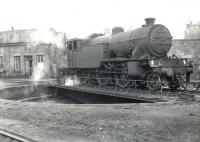
G H Robin collection by courtesy of the Mitchell Library, Glasgow 22/10/1960
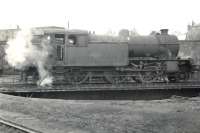
G H Robin collection by courtesy of the Mitchell Library, Glasgow 22/10/1960
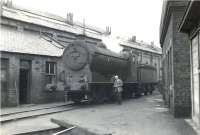
G H Robin collection by courtesy of the Mitchell Library, Glasgow 22/10/1960
This is a three platform terminus with a glazed roof. (It was four, but one platform's track is lifted.) There is a circulating area, covered by a glazed barrel ceiling with a small shop. The ticket office is by the main entrance off East Princes Street. At this entry is a two storey building facing the street, with a private lane on its west side. There is also a passageway entrance from the ...
More details
John McIntyre 02/09/2021
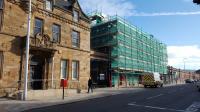
Beth Crawford 28/09/2018
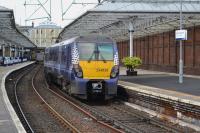
...
Bill Roberton 09/10/2017
Books










